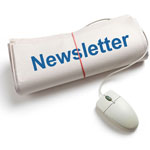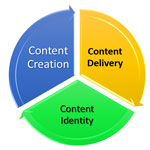It’s for about one and half year that I send a weekly newsletter to my readers in my Persian websites (shabanli.com & motamem.org). I’m proud of having tens of thousands of people subscribed to my weekly email newsletter open it with an incredible steady rate of 50-55 percent just in the first 24 hours.
I’m proud of having tens of thousands of people subscribed to my weekly E-Newsletter. Most of them are active subscribers and open the emails with an incredible steady rate of 50-55 percent just in the first 24 hours.
Although the design of my newsletter has undergone various changes and still evolves to satisfy my current subscribers and to attract new ones; I’m already happy with it.
So I decided to share my experiences in writing an effective E-Newsletter here.
1. Preparing and sending weekly newsletter is a long term investment.
Never believe in anyone who tries to convince you that you will have a high return on your investment within a couple of weeks.
I think that in most cases you won’t even see the return of your investment in the short-term or mid-term. But don’t worry. Developing and publishing an effective, engaging E-Newsletter, would be one of your most rewarding decisions in long-run.
2. Sending newsletters to the people who have not asked for a newsletter is not a wise decision. If someone advised you to do so, send him generously to your competitor at your cost.
Sending bulk emails to every email list you’ve found will lead to some results. That’s for sure.
But it’s the most expensive content marketing strategy and considering all tangible and intangible costs, the cost of such campaigns exceeds the benefits.
Every unwanted message irritates the user, and a beg-for-click approach will ruin your brand in long-run.
Do your homework and prepare the best possible E-Newsletter. Your subscribers will forward it to the others, and your subscriber community will grow.
The logic behind is so simple: If your content is helpful, no one likes to be a second-hand receiver.
3. The formal style of writing is not attractive anymore.
The corporate-style email writing is not the key to trust or success anymore.
As most of your subscribers receive many formal messages every day, no one looks for more.
They are looking for an informal, casual style of writing and a message to be read in their coffee time whether in the office or at home.
4. Provide your readers with the quotable information.
It would be too optimistic to suppose that the majority of people look for the knowledge to put it into the practice.
Sure using the content in life or business is one of its applications but not the most important one (at least for most of us).
Quoting is the most practical use of every piece of content.
Write a piece of content titled “How not to be stupid in the workplace” and show it to your friends.
I bet that even before reading it, most of them will tell you: “YES! I have a colleague who must read this!”
Designing and creating a quotable or viral content has its own tips and tricks which I will write about in future.
5. Use original content as much as possible.
As I have mentioned before, no one likes to be a second-hand receiver of good content.
So the major part of your content has to be original.
Hiding the source doesn’t make you an original publisher. Even if you hide your sources, sooner or later someone will find them, and you will lose their trust.
So if you use any source for curation of the content, you have to specify it explicitly and honestly.
6. Neither pure-click nor full-content are the best email content. Try to find an optimum combination.
Some of the newsletters are pure-click emails. Full of links and tempting headlines trying to seduce the reader to click on them. Some other newsletters have taken the exact opposite side. They are full-
Full of links and tempting headlines trying to seduce the reader to click on them. Some other newsletters have taken the exact opposite side. They are full-
Some other newsletters have taken the exact opposite approach. They are full-content emails. These emails are a combination of texts and illustrations in such a way that you will lose nothing if you print them out on the paper.
These emails are a combination of texts and illustrations in such a way that you will lose nothing if you print them out on the paper.
Pure-click emails will become boring and even irritating after some time. According to my experience and also experiences of other friends, subscribers of such letters will not stay loyal to them and this strategy will lead to lower open-rate and higher unsubscribe rate in the long-run.
According to my experience and also experiences of the other friends, subscribers of such letters will not stay loyal to them and this strategy will lead to lower open rates and higher unsubscribe rates in the long-run.
Full-content emails have other downsides.
First of all, your subscriber will not visit your website anymore; If there’s something important, they will tell me via email.
The second problem is that a full-content email is not a newsletter anymore. It will be closer to a newspaper or magazine, and your subscriber will unconsciously compare its quality and content with his/her favorite newspaper or magazine, and sure you know who will be the winner.
7. If you’d like your subscribers to do something, ask them to do it.
You may not believe me, but I firmly believe that in spite of existing hype around the highly interactive digital media, nowadays the audiences are more passive than ever.
Just test it as I have tested:
Put a hyperlink in your email and send it to half of your subscribers:
Here is a hyperlink to a very nice article.
At the same time, test a different style with the other half:
Here is a hyperlink to a very nice article; please click on it.
You won’t believe me. But I have even tested a third style:
Here is a hyperlink to a very nice article, please click on it and write there your opinion.
You can’t imagine the incredible difference between results of these three emails.
Users of the digital age, facing an overflow of information and overflood of notifications have turned into passive non-thinking robots.You may love it or hate it. But it’s the fact. Test it with your next newsletter.
8. Sometimes full-text emails can be more successful.
I’m nearly sure that even if you trust me on the previous point, still you will not believe this one.
Take a look at the most popular newsletter recommendation lists and you will find a standard advice there in the first lines: Make a combination of text and picture.
Yes. It can make your newsletter attractive. But will it make your newsletter a differentiated one? I don’t think so.
People get used to any attraction, but they will never get used to the differentiation.
Nowadays, every email is full of photos and click-on-me-banners and irritating colors and please-look-at-me dancing-gifs.
If you want to be one of them, just do it. But if you are aiming at a differentiated newsletter, there might be the better options.
Any newsletter is kind of letter after all, and any letter has to be informative before anything else and images are more a tool for the attraction than a piece of information.
I’m not against combining photos and the text. But just please double-check your decision before blindly following the popular practice.
The Popular practice is not necessarily the best practice.
9. Don’t limit yourself to the contents you have generated by your own.
We all have heard that content is king. But just a highly optimistic king would try to expand his territory with the soldiers of the others! This is the reason that in any website, it’s neither strategic nor prestigious to use the contents of the others excessively.
But the situation is a bit different in newsletters. The first aim of a weekly newsletter is earning subscribers and if there’s any way to provide value to them, just use it.
Offering them some links of the week from the other publishers would make every subscriber happy if you select them carefully considering interests of your audience.
Quoting sentences or paragraphs from the famous authors or interesting books would make everyone happy.
Don’t forget that newsletters are not supposed to produce the news; they are expected to deliver the news to the audience.
But there’s one thing to hold in your mind every time you quote any content from any publisher: Never Steal their traffic.
Beyond all official rules and laws, there’s an ethical practice in quoting the content.
Every publisher has invested in the content to attract the target receivers and convert them to the active audiences. Quoting the whole content or forgetting to mention the access address to the owner is not a professional act.
10. Consider a limit for advertising material.
We are all fed up with advertising materials, and no one looks for more. In the outdoor advertising, the advertisers are looking for the most exposure, but this is not the case in digital newsletters. In our today’s overcrowded market, every subscriber feels a permanent temptation to unsubscribe from your list. So never trigger them to do so. This is the reason that I never dedicate more than 10% of the whole newsletter space to the ads.
In our today’s overcrowded market, every subscriber feels a permanent temptation to unsubscribe from your list.
So never trigger them to do so. This is the reason that I never consider more than 10% of the whole newsletter space to the ads (whether direct or indirect ones).
11. Provide them with downloadable content.
Tina Seelig notes a critical point in her fantastic book called What I Wish I Knew When I Was 20:
People waiting in a long restaurant queue would easily pay you to get your position if you are far before them.
But they would pay more if you give them the electronic notification device you have received from the restaurant.
It means that for most of us, any tangible object would be more favorable than an intangible service with the same characteristics.
The same holds true in the digital world.
Having a link to an article would be good. But a downloadable pdf file would be great.
Streaming music is nice, but I feel if I could have it downloaded on my computer.
So even if your subscribers are already happy and satisfied with the links you have provided them, still consider some downloadable pdf files or audio files in your weekly newsletter.







